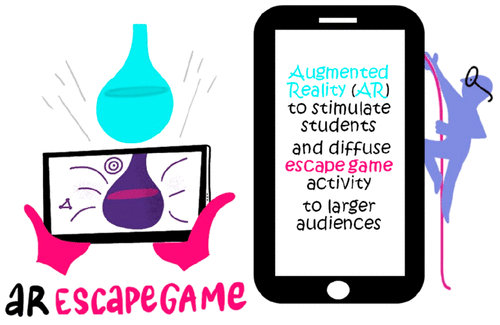当前位置:
X-MOL 学术
›
J. Chem. Educ.
›
论文详情
Our official English website, www.x-mol.net, welcomes your feedback! (Note: you will need to create a separate account there.)
Using Augmented Reality to Stimulate Students and Diffuse Escape Game Activities to Larger Audiences
Journal of Chemical Education ( IF 3 ) Pub Date : 2020-03-31 , DOI: 10.1021/acs.jchemed.9b00933 Anabela Estudante 1 , Nicolas Dietrich 2
Journal of Chemical Education ( IF 3 ) Pub Date : 2020-03-31 , DOI: 10.1021/acs.jchemed.9b00933 Anabela Estudante 1 , Nicolas Dietrich 2
Affiliation

|
In a world engaged in a perpetual race for progress, augmented reality (AR) is a new frontier that has attracted much research attention in recent years. The generalization of smartphones and the miniaturization and democratization of connected gadgets are leading to new uses and new expectations. In this article, we provide an AR application to the trending educational activity of escape games in order to diffuse AR to a large audience. As the application of an educational escape game, which is a good tool to improve the motivation and communication skills of students, requires considerable time for design, manufacturing, and operating, a numeric, mobile AR version is proposed here. For this purpose, an original paper-based version of the scenario is presented, principally turning around the Solvay process for a high school/college audience. In this scenario, the students are led to follow in the footsteps of a young Belgian physicist, Ernest Solvay. Through enigmas, participants discover a secret room containing Solvay’s secrets in Brussels. Puzzles about the periodic table of elements, the CPK color code, chemical reaction balancing, the notion of molar mass, the Solvay process, or the philanthropic conferences organized by Solvay and the many other scientists involved are used to illustrate the chemical process discovered. This scenario and the Leblanc process scenario have been adapted to an AR experience with the open application Metaverse. Unlike conventional escape game or escape lab activities, our AR escape games can be easily diffused to large audience classrooms without the presence of any teacher being required and without any systematic preparation. The advantages and limits of such tools are discussed. The feedback received from students that participated in a test exercise with the tool corroborates the increase of motivation through such activities.
中文翻译:

利用增强现实刺激学生并向更大范围的观众扩散逃生游戏活动
在一个不断追求进步的世界中,增强现实(AR)是新兴领域,近年来引起了很多研究关注。智能手机的普及以及互联小工具的小型化和民主化正在带来新的用途和新的期望。在本文中,我们为逃避游戏的流行教育活动提供了一个AR应用程序,以便将AR传播给广大受众。由于教育性逃生游戏的应用是提高学生的动机和沟通技巧的良好工具,需要大量的设计,制造和操作时间,因此在此提出了一种数字移动AR版本。为此目的,提出了该方案的原始纸质版本,主要是针对高中/大学观众改变了Solvay流程。在这种情况下,引导学生跟随年轻的比利时物理学家欧内斯特·索尔维(Ernest Solvay)的脚步。通过谜团,参与者发现了一个包含苏威在布鲁塞尔的秘密的秘密房间。关于元素周期表,CPK颜色代码,化学反应平衡,摩尔质量的概念,索尔维过程或由索尔维和许多其他参与的科学家参加的慈善会议的难题被用来说明发现的化学过程。此场景和Leblanc流程场景已通过开放应用程序Metaverse适应了AR体验。与传统的逃生游戏或逃生实验室活动不同,我们的AR逃生游戏可以轻松地散布到大型观众教室,而无需任何老师在场且无需任何系统准备。讨论了此类工具的优点和局限性。从参加该工具测试练习的学生那里获得的反馈证实了通过此类活动增加的动力。
更新日期:2020-03-31
中文翻译:

利用增强现实刺激学生并向更大范围的观众扩散逃生游戏活动
在一个不断追求进步的世界中,增强现实(AR)是新兴领域,近年来引起了很多研究关注。智能手机的普及以及互联小工具的小型化和民主化正在带来新的用途和新的期望。在本文中,我们为逃避游戏的流行教育活动提供了一个AR应用程序,以便将AR传播给广大受众。由于教育性逃生游戏的应用是提高学生的动机和沟通技巧的良好工具,需要大量的设计,制造和操作时间,因此在此提出了一种数字移动AR版本。为此目的,提出了该方案的原始纸质版本,主要是针对高中/大学观众改变了Solvay流程。在这种情况下,引导学生跟随年轻的比利时物理学家欧内斯特·索尔维(Ernest Solvay)的脚步。通过谜团,参与者发现了一个包含苏威在布鲁塞尔的秘密的秘密房间。关于元素周期表,CPK颜色代码,化学反应平衡,摩尔质量的概念,索尔维过程或由索尔维和许多其他参与的科学家参加的慈善会议的难题被用来说明发现的化学过程。此场景和Leblanc流程场景已通过开放应用程序Metaverse适应了AR体验。与传统的逃生游戏或逃生实验室活动不同,我们的AR逃生游戏可以轻松地散布到大型观众教室,而无需任何老师在场且无需任何系统准备。讨论了此类工具的优点和局限性。从参加该工具测试练习的学生那里获得的反馈证实了通过此类活动增加的动力。


























 京公网安备 11010802027423号
京公网安备 11010802027423号